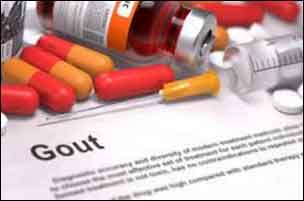- Home
- Editorial
- News
- Practice Guidelines
- Anesthesiology Guidelines
- Cancer Guidelines
- Cardiac Sciences Guidelines
- Critical Care Guidelines
- Dentistry Guidelines
- Dermatology Guidelines
- Diabetes and Endo Guidelines
- Diagnostics Guidelines
- ENT Guidelines
- Featured Practice Guidelines
- Gastroenterology Guidelines
- Geriatrics Guidelines
- Medicine Guidelines
- Nephrology Guidelines
- Neurosciences Guidelines
- Obs and Gynae Guidelines
- Ophthalmology Guidelines
- Orthopaedics Guidelines
- Paediatrics Guidelines
- Psychiatry Guidelines
- Pulmonology Guidelines
- Radiology Guidelines
- Surgery Guidelines
- Urology Guidelines
Gout patients at increased risk of VTE independent of urate-lowering therapy

UK: Gout patients are at increased risk for venous thromboembolism (VTE) regardless of exposure to urate-lowering therapy. Also, the increased risk is independent of hospital admission and is particularly high in the younger population.
These are the results of a recent study published in the CMAJ journal.
Gout is the most common inflammatory arthritis affecting 2.4% of adults and typically affects older populations. It is caused by the accumulation of uric acid in the joint. Systemic inflammatory diseases have been associated with an increased risk of venous thromboembolism.
Alyshah Abdul Sultan, Research Institute for Primary Care & Health Sciences, Keele University, UK, and colleagues aimed to quantify VTE risk in gout patients and to assess how disease duration, hospital admission and urate-lowering therapy affect this risk.
For the purpose, the researchers collected data from the Clinical Practice Research Datalink in the United Kingdom. They then individually matched gout cases 1:1 to control patients without gout and calculated VTE risks and then stratified the risks by age, sex, and hospital admission.
Also Read: Despite readily available treatment, gout remains under-treated, finds study
Key findings of the study include:
- Researchers identified 142,474 unique hospital admissions. Researchers initially classified 529 cases of VTE resulting from a hospital stay; however, they recategorized 121 of these cases to indicate that VTE was the cause of the hospital admission rather than a result.
- Gout was associated with a higher risk of venous thromboembolism compared with controls (absolute rate 37.3 v. 27.0 per 10 000 person-years).
- The excess risk in patients with gout, which was sustained up to a decade after diagnosis, was present during the time outside hospital stay, but not during it.
- The risk of venous thromboembolism was similar among patients prescribed versus not prescribed urate-lowering therapy.
- During the in-hospital period, investigators noted no differences in the rate of VTE between gout and control groups.
- Researchers noted higher rates of VTE in the gout group compared with controls within one year of disease diagnosis (34 vs 19/10,000 person-years).
Also Read: Exposure to occupational inorganic dust may increase gout risk
"Although our observed excess risk may not be sufficient to warrant preventive intervention on its own, there may be a need for clinical vigilance in younger patients with a new diagnosis of gout, with further research needed to establish the impact of gout severity on the risk of venous thromboembolism," concluded the authors.
For full access to the study follow the link: https://doi.org/10.1503/cmaj.180717

Disclaimer: This site is primarily intended for healthcare professionals. Any content/information on this website does not replace the advice of medical and/or health professionals and should not be construed as medical/diagnostic advice/endorsement or prescription. Use of this site is subject to our terms of use, privacy policy, advertisement policy. © 2020 Minerva Medical Treatment Pvt Ltd